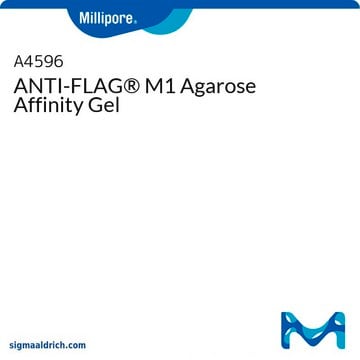Recommended Products
form
liquid
mol wt
~49 kDa
shipped in
dry ice
storage temp.
−20°C
General description
Carboxy-terminal FLAG-BAP Fusion Protein is a 466 amino acid C-terminal FLAG fusion protein of E.coli bacterial alkaline phosphatase (BAP).
Application
Carboxy-terminal FLAG-BAP™ Fusion Protein has been used in the immunoprecipitation of the reporter protein in human embryonic kidney (HEK) cell lysate and as a FLAG-tagged control protein in solid-phase binding assay of spermatogenic immunoglobulin superfamily protein (SgIGSF).
Learn more product details in our FLAG® application portal.
Biochem/physiol Actions
The FLAG sequence comprises of the eight-amino acid sequence AspTyrLysAspAspAspAspLys and is hydrophilic. FLAG fusion proteins are expressed in bacterial, yeast and mammalian cells. FLAG epitope-tagged bacterial alkaline phosphatase is employed in immunoaffinity purification. Alkaline phosphatase based fusion protein have wide clinical applications in immunodetection, enzyme immunoassay and enzyme-linked immunosorbent assay.
Other Notes
Control protein
Physical form
Supplied in 10 mM Tris, 120 mM NaCl, 0.05 mM ZnCl2
Preparation Note
Dilute the ANTI-FLAG M2 antibody solution to 10 mg/ml
Legal Information
FLAG is a registered trademark of Merck KGaA, Darmstadt, Germany
FLAG-BAP is a trademark of Sigma-Aldrich Co. LLC
Storage Class Code
10 - Combustible liquids
WGK
WGK 3
Flash Point(F)
Not applicable
Flash Point(C)
Not applicable
Personal Protective Equipment
dust mask type N95 (US), Eyeshields, Gloves
Certificates of Analysis (COA)
Search for Certificates of Analysis (COA) by entering the products Lot/Batch Number. Lot and Batch Numbers can be found on a product’s label following the words ‘Lot’ or ‘Batch’.
Already Own This Product?
Find documentation for the products that you have recently purchased in the Document Library.
Customers Also Viewed
Cloning of a soluble isoform of the SgIGSF adhesion molecule that binds the extracellular domain of the membrane-bound isoform
Koma Y, et al.
Oncogene, 23(33), 5687-5687 (2004)
Eldie Berger et al.
Microbial cell factories, 10, 62-62 (2011-08-05)
Through modification of the flagellin type III secretion pathway of Bacillus halodurans heterologous peptides could be secreted into the medium as flagellin fusion monomers. The stability of the secreted monomers was significantly enhanced through gene-targeted inactivation of host cell extracellular
Improved methodology for the affinity isolation of human protein complexes expressed at near endogenous levels
Domanski M, et al.
Biotechniques, 1-1 (2012)
Microbial alkaline phosphatases in bioprocessing
Nalini P, et al.
International Journal of Current Microbiology and Applied Sciences, 4(3), 384-396 (2015)
Maddalena de Virgilio et al.
Journal of experimental botany, 59(10), 2815-2829 (2008-06-10)
Protein bodies (PB) are stable polymers naturally formed by certain seed storage proteins within the endoplasmic reticulum (ER). The human immunodeficiency virus negative factor (Nef) protein, a potential antigen for the development of an anti-viral vaccine, is highly unstable when
Our team of scientists has experience in all areas of research including Life Science, Material Science, Chemical Synthesis, Chromatography, Analytical and many others.
Contact Technical Service











